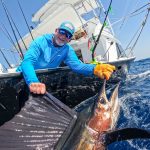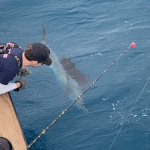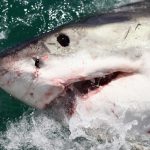Dominican Republic, Snook Record, Loop Current Off FL & Oil Research for West FL Shelf
NEWS
ROFFS™ Contemplates NEW Dominican Republic area

New Snook Record is Being Evaluated
Orlando snook fishing guide Ward Michaels may be headed for the world record book with a 60-pound Pacific snook he caught in Costa Rica two weeks ago.
Michaels, who has made more than 80 trips in 27 years to both coasts of Costa Rica for snook, called three friends from Texas when he knew the time was right for huge spawning females along the central Pacific coast.
“I told them to come on. The time is now,” said Michaels, who owns Michaels Hunting and Fishing, Inc., a sportsman’s booking and guiding agency in Orlando. Please click HERE to read more on our website…

Favorable Conditions Offshore of Tampa, FL
We are able to use today’s infrared SST imagery data and yesterday’s MODIS ocean color/chlorophyll imagery, to provide this analysis for this area. Overall, the 80.0°F main body of the Loop Current is present in the south of the analysis area. To the north of the Loop Current, filaments of blue 77.0°F Loop Current water is pushing inshore over the Steps and the Box areas, creating favorable conditions for tuna, wahoo, dolphin and billfish action over 200-1000 fathom depths. Areas marked with the hot spot dots and the numbers two inside suggest increased chances for fishing action, as they are areas where we observed favorable ocean conditions for two days now. Please keep in mind that while we continue to use a combination of NOAA buoys to calibrate our SST on a daily basis to what you will find while out on the water during the morning hours. As always, remember to look for relative rather than absolute SST. On your way offshore, be sure to keep an eye out for weedlines and feeding birds, as they are strong indicators of water mass boundary convergence zones, which are known to concentrate baitfish and target fish. Please click HERE to view the FULL analysis on our website…

Oil Research for Western Florida Shelf Area
The coastal ocean region known as the WFS includes waters east of the DeSoto Canyon and south to the Florida Straits. Oil from the Deepwater Horizon wellhead landed on northwestern Florida panhandle beaches in June of 2010. For three weeks, satellite and aerial images with accompanying model simulations showed oil moving on surface waters further east, close to Cape San Blas, then it receded and was no longer visible in that area. However, public and scientist findings were emerging that indicated compounds from this oil – though no longer visible – continued to impact the WFS marine environment.

![]() If you do not want to wait for our next Fishy Times newsletter, please visit us in the meantime to get all your fishing news on Facebook, Twitter, YouTube and on the web. Safe and successful fishing until next time!
If you do not want to wait for our next Fishy Times newsletter, please visit us in the meantime to get all your fishing news on Facebook, Twitter, YouTube and on the web. Safe and successful fishing until next time!






